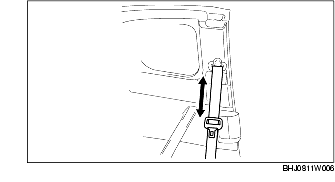
1. Verify that the belt is installed properly with no twisting or kinks.
2. Verify that there is no damage to the seat belt and no deformation of the metal fittings.
1. Verify that the belt can be pulled out smoothly, and that it retracts smoothly.
2. Verify that the retractor locks when the belt is pulled quickly.
3. Remove the retractor.
4. While pulling the seat belt out, make sure that the seat belt does not lock when the retractor is tilted slowly up to 15° from the mounted position and locks when the retractor is tilted 40° or more.
1. Pull the belt out fully to change the lock mode from ELR to ALR.
2. Verify that retractor makes a clicking sound as the belt slowly retracts. If no sound is heard, the lock mode has not changed to ALR. If necessary, repeat Step 1.
3. Verify that the retractor locks when pulled.
4. Verify that the lock mode changes to ELR when the belt is fully pulled out.
1. If the vehicle has been subjected to a shock in an accident, pull the belt from the retractor and confirm that there are no wear tracks (the load limiter has not operated) by visually inspecting and feeling the belt.
1. With the front seat belts unbuckled, close all the doors (door switch off).
2. Open either one of the front doors, then press the door switch by hand (door switch off).
3. When releasing the door switch (door switch on), confirm on both sides that the operation sound of the lock release solenoids is heard.
4. With the front seat belts unbuckled, open all the doors (door switch on).
5. When either one of driver-side or passenger-side seat belts is buckled (front buckle switch on), confirm that the operation sound of the lock release solenoid is heard for the buckled seat belt (lock release solenoid off).